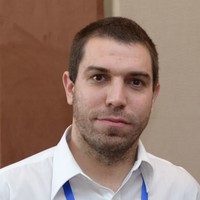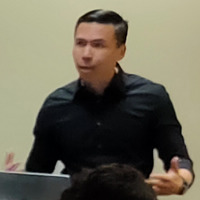
Adolfo García
Adolfo García, Ph.D., specializes in the neuroscience of language. He serves as Director of the Cognitive Neuroscience Center (Universidad de San Andrés, Argentina), Senior Atlantic Fellow at the Global Brain Health Institute (University of California, San Francisco), and Associate Researcher at Universidad de Santiago de Chile. He is also co-founder of Include, a global network for crosslinguistic research on brain health; and creator of TELL, a speech testing app. He has obtained funds from multiple international agencies, including a USD 8.3 million grant from the National Institutes of Health on linguistic markers of dementia. He has authored more than 200 publications and offered 250 presentations. His science communication milestones include a TEDx talk with a live audience of 12,000 persons, the TV show “Of brains and words,” the video series “Language, brain, and body,” the radio column “Mind and communication,” and the documentary “Impulso sonoro” (Canal Encuentro). His contributions have been recognized by the Linguistic Association of Canada and the United States, the Argentine Association of Behavioral Science, the Legislature of the City of Buenos Aires, the Alzheimer’s Association, and Harvard’s Ig Nobel awards. He also received the Early Career Award, from the Society for the Neurobiology of Language; and the UpLink Top Innovator Award, from the World Economic Forum.
Address: Mar Del Plata, Buenos Aires, Argentina
Address: Mar Del Plata, Buenos Aires, Argentina
less
Related Authors
Na'ama Pat-El
The University of Texas at Austin
Sarah-Jayne Blakemore
University College London
Michael Spivey
University of California, Merced
Oleg Yu Vorobyev
Siberian Federal University
Bert Vaux
University of Cambridge
Inma Alvarez
The Open University
Louis de Saussure
University of Neuchâtel
Armando Marques-Guedes
UNL - New University of Lisbon
Adam M Croom
Case Western Reserve University
Eitan Grossman
The Hebrew University of Jerusalem
InterestsView All (14)










Uploads
Books by Adolfo García
Across individual and interpersonal settings, meaning is influenced by external and internal processes bridging phenomenological and biological dimensions. Yet, each of these dyads has been segregated into discipline-specific topics, with attempts to chart their intersections proving preliminary at best. Bringing together perspectives from world-leading experts, this volume seeks to overcome these disciplinary divides between the social and the natural sciences at both empirical and theoretical levels. Chapters chart the foundations of neurosemiotics; characterize linguistic and interpersonal dynamics as shaped by neurocognitive, bodily, situational, and societal factors; and examine other daily neurosemiotic occurrences driven by faces, music, tools, and even visceral signals.
This comprehensive volume is a state-of the-art resource for students and researchers interested in how humans and other animals construe experience, in such fields as cognitive neuroscience, biosemiotics, philosophy of mind, neuropsychology, neurolinguistics, and evolutionary biology.
Biology, on the one hand, has an important and impressive history of studying the systematicity of nature, as it is exhibited in the analyses of the genetic, physiological and morphogenetic processes of living systems. Yet biology, at the same time, must also certainly recognize that it is likewise the study of the systematicity of freedom, in as much as its object of study is the phenomenon of life itself. And so biology, understood as biosemiotics, studies life’s capacity for aboutness, for establishing mediated and arbitrary relationships that result in the creation of novelty, for making choices, and for the ongoing exploration of possibility.
The world meetings on biosemiotics – Gatherings in Biosemiotics – have been taking place annually since 2001. The first twelve years of these conferences was described in a volume of 2012, while the current volume covers the meetings from 2012 to 2020. In addition to the accounts and programs of these events, and including over sixty contributions to the twentieth meeting, the current volume includes review articles, evaluating the work done thus far, and predicting future developments. The history and philosophy of Czech biosemiotics, in particular, receives a detailed account, and many other new ideas in biosemiotics are also discussed in this book.
for the field. This book aims to integrate the community of experts across the globe and the region, and to establish new challenges and developments for future investigation. We present research focused on neurodegenerative research in South America. We introduce studies assessing the interplay among genetic, neural, and behavioral dimensions of these diseases, as well as articles on vulnerability factors, comparisons of findings from various countries, and works promoting multicenter and collaborative networking. More generally, our book covers a broad scope of human-research approaches (behavioral assessment, neuroimaging, electromagnetic techniques, brain connectivity, peripheral measures), animal methodologies (genetics, epigenetics, proteomics, metabolomics, other molecular biology tools), species (all human and non-human animals, sporadic, and genetic versions), and article types (original research, review, and opinion papers). Through this wide-ranging proposal, we hope to introduce a fresh approach to the challenges and opportunities of research on
neurodegeneration in South America.
Neuroscience and Social Science – The Missing Link puts together contributions by experts interested in the convergences, divergences, and controversies across these fields. The volume presents empirical studies on the interplay between relevant levels of inquiry (neural, psychological, social), chapters rooted in specific scholarly traditions (neuroscience, sociology, philosophy of science, public policy making), and proposals of new theoretical foundations to enhance the rapprochement in question.
Across individual and interpersonal settings, meaning is influenced by external and internal processes bridging phenomenological and biological dimensions. Yet, each of these dyads has been segregated into discipline-specific topics, with attempts to chart their intersections proving preliminary at best. Bringing together perspectives from world-leading experts, this volume seeks to overcome these disciplinary divides between the social and the natural sciences at both empirical and theoretical levels. Chapters chart the foundations of neurosemiotics; characterize linguistic and interpersonal dynamics as shaped by neurocognitive, bodily, situational, and societal factors; and examine other daily neurosemiotic occurrences driven by faces, music, tools, and even visceral signals.
This comprehensive volume is a state-of the-art resource for students and researchers interested in how humans and other animals construe experience, in such fields as cognitive neuroscience, biosemiotics, philosophy of mind, neuropsychology, neurolinguistics, and evolutionary biology.
Biology, on the one hand, has an important and impressive history of studying the systematicity of nature, as it is exhibited in the analyses of the genetic, physiological and morphogenetic processes of living systems. Yet biology, at the same time, must also certainly recognize that it is likewise the study of the systematicity of freedom, in as much as its object of study is the phenomenon of life itself. And so biology, understood as biosemiotics, studies life’s capacity for aboutness, for establishing mediated and arbitrary relationships that result in the creation of novelty, for making choices, and for the ongoing exploration of possibility.
The world meetings on biosemiotics – Gatherings in Biosemiotics – have been taking place annually since 2001. The first twelve years of these conferences was described in a volume of 2012, while the current volume covers the meetings from 2012 to 2020. In addition to the accounts and programs of these events, and including over sixty contributions to the twentieth meeting, the current volume includes review articles, evaluating the work done thus far, and predicting future developments. The history and philosophy of Czech biosemiotics, in particular, receives a detailed account, and many other new ideas in biosemiotics are also discussed in this book.
for the field. This book aims to integrate the community of experts across the globe and the region, and to establish new challenges and developments for future investigation. We present research focused on neurodegenerative research in South America. We introduce studies assessing the interplay among genetic, neural, and behavioral dimensions of these diseases, as well as articles on vulnerability factors, comparisons of findings from various countries, and works promoting multicenter and collaborative networking. More generally, our book covers a broad scope of human-research approaches (behavioral assessment, neuroimaging, electromagnetic techniques, brain connectivity, peripheral measures), animal methodologies (genetics, epigenetics, proteomics, metabolomics, other molecular biology tools), species (all human and non-human animals, sporadic, and genetic versions), and article types (original research, review, and opinion papers). Through this wide-ranging proposal, we hope to introduce a fresh approach to the challenges and opportunities of research on
neurodegeneration in South America.
Neuroscience and Social Science – The Missing Link puts together contributions by experts interested in the convergences, divergences, and controversies across these fields. The volume presents empirical studies on the interplay between relevant levels of inquiry (neural, psychological, social), chapters rooted in specific scholarly traditions (neuroscience, sociology, philosophy of science, public policy making), and proposals of new theoretical foundations to enhance the rapprochement in question.
Education influences brain health and dementia. However, its impact across regions, specifically Latin America (LA) and the United States (US), is unknown.
METHODS
A total of 1412 participants comprising controls, patients with Alzheimer's disease (AD), and frontotemporal lobar degeneration (FTLD) from LA and the US were included. We studied the association of education with brain volume and functional connectivity while controlling for imaging quality and variability, age, sex, total intracranial volume (TIV), and recording type.
RESULTS
Education influenced brain measures, explaining 24%–98% of the geographical differences. The educational disparities between LA and the US were associated with gray matter volume and connectivity variations, especially in LA and AD patients. Education emerged as a critical factor in classifying aging and dementia across regions.
DISCUSSION
The results underscore the impact of education on brain structure and function in LA, highlighting the importance of incorporating educational factors into diagnosing, care, and prevention, and emphasizing the need for global diversity in research.
Highlights
Lower education was linked to reduced brain volume and connectivity in healthy controls (HCs), Alzheimer's disease (AD), and frontotemporal lobar degeneration (FTLD).
Latin American cohorts have lower educational levels compared to the those in the United States.
Educational disparities majorly drive brain health differences between regions.
Educational differences were significant in both conditions, but more in AD than FTLD.
Education stands as a critical factor in classifying aging and dementia across regions.
Native-likeness (similarity between non-native and native users of the same language) depends on second language proficiency (L2p). However, evidence comes mainly from phonological or syntactic tasks, prompting an underexplored question: can higher L2p also entail a more native-like organization of semantic memory?
Methodology:
We asked high and low proficiency bilinguals to describe concepts in their second (English) and first (Spanish) language. We then compared their responses with semantic structure norms from native speakers of each language, and derived measures of semantic native-likeness through a validated semantic proximity measure.
Data and analysis:
We examined whether semantic native-likeness scores discriminated between high and low L2p levels at the group level (via inferential statistics) and at the individual level (via machine learning analyses).
Findings:
We found that semantic associations in English were more native-like in high than in low L2p bilinguals. Machine learning analyses showed that this pattern was highly consistent across individual subjects. Responses in Spanish did not differ between groups.
Originality:
This is the first study assessing semantic native-likeness through concept-feature associations in high and low L2p bilinguals, both at the group- and the individual-level.
Significance:
Our findings suggest that increased L2p entails a more native-like organization of semantic memory, informing models of bilingual cognition and its links with experience-related variables.
While Latin America (LatAm) is facing an increasing burden of dementia due to the rapid aging of the population, it remains underrepresented in dementia research, diagnostics, and care.
METHODS
In 2023, the Alzheimer's Association hosted its eighth satellite symposium in Mexico, highlighting emerging dementia research, priorities, and challenges within LatAm.
RESULTS
Significant initiatives in the region, including intracountry support, showcased their efforts in fostering national and international collaborations; genetic studies unveiled the unique genetic admixture in LatAm; researchers conducting emerging clinical trials discussed ongoing culturally specific interventions; and the urgent need to harmonize practices and studies, improve diagnosis and care, and use affordable biomarkers in the region was highlighted.
DISCUSSION
The myriad of topics discussed at the 2023 AAIC satellite symposium highlighted the growing research efforts in LatAm, providing valuable insights into dementia biology, genetics, epidemiology, treatment, and care.
CTIS is an interdisciplinary space that aims to generate and apply knowledge about the mental operations underlying translation and interpreting. Its roots maybetraced to the mid-twentieth century, when Eugene Nida (Nida 1964; Nida & Taber 1969) and Danica Seleskovitch (Seleskovitch 1968, 1975) spearheaded cognitive accounts of translation (based on rationalist theoretical premises) and interpreting (drawing on non-participant observation), respectively. Nonexperimental approaches accounts continued to be prevalent in the 1980s, during a phase dominated by think-aloud protocols– i.e., paradigms whereby participants are asked to verbalize their decisions and thoughts during or after translation tasks (Bernardini 2001). The progress thus made was accompanied by a growing need for objective insights, which began to be systematically met in the 1990s. Building mainly on keystroke logging methods (e.g., Jakobsen 1995, 1998; Jensen & Jakobsen 2000), leading efforts in this decade sought to integrate qualitative and quantitative data, in what became known as triangulation (Alves 2003; Jakobsen 1998). These transitions, in general, and the incorporation of experimental approaches, in particular, lay the groundwork for the development of CTIS in the twenty-first century.
Participants described a picture, and ensuing transcripts were analyzed via part-of-speech tagging to extract sentence-related features (e.g., subordinating and coordinating conjunctions), verbal-related features (e.g., tense markers), and nominal-related features (e.g., subjective and possessive pronouns). Gradient boosting machines were used to classify between groups using all features. We identified the most discriminant morphosyntactic marker via a feature importance algorithm and examined its neural correlates via voxel-based morphometry.
Individuals with nfvPPA produced fewer morphosyntactic elements than the other two groups. Such features robustly discriminated them from both individuals with lvPPA and HCs with an AUC of .95 and .82, respectively. The most discriminatory feature corresponded to subordinating conjunctions was correlated with cortical atrophy within the left posterior inferior frontal gyrus across groups (pFWE < .05).
Automated morphosyntactic analysis can efficiently differentiate nfvPPA from lvPPA. Also, the most sensitive morphosyntactic markers correlate with a core atrophy region of nfvPPA. Our approach, thus, can contribute to a key challenge in PPA diagnosis.
Clinical understanding of primary progressive aphasia (PPA) has been primarily derived from Indo-European languages. Generalizing certain linguistic findings across languages is unfitting due to contrasting linguistic structures. While PPA patients showed noun classes impairments, Chinese languages lack noun classes. Instead, Chinese languages are classifier language, and how PPA patients manipulate classifiers is unknown.
METHODS
We included 74 native Chinese speakers (22 controls, 52 PPA). For classifier production task, participants were asked to produce the classifiers of high-frequency items. In a classifier recognition task, participants were asked to choose the correct classifier.
RESULTS
Both semantic variant (sv) PPA and logopenic variant (lv) PPA scored significantly lower in classifier production task. In classifier recognition task, lvPPA patients outperformed svPPA patients. The classifier production scores were correlated to cortical volume over left temporal and visual association cortices.
DISCUSSION
This study highlights noun classifiers as linguistic markers to discriminate PPA syndromes in Chinese speakers.